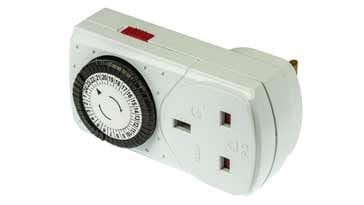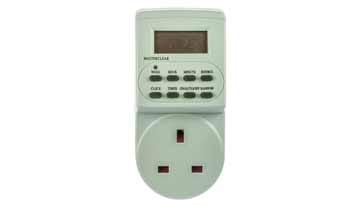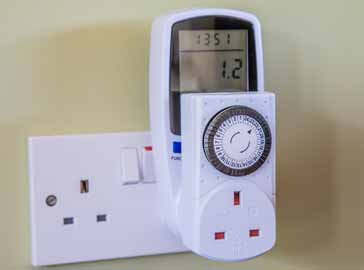Electric Plug-In Timer Switch
One way of automatically turning electric appliances on and off is to use a plug-in electric timer socket - they are simple, cheap and easy to use.
Energy Saving Technology Includes:
Home energy saving technology
Guidelines for home energy saving
List of energy saving gadgets
How to choose best LED light bulbs
Plug-in timer switches
Plug-in power meter / usage monitor
Although electric timer plugs are often used to control lighting within a house to make it look lived in, or other simple functions like that, they can also be used imaginatively to help reduce energy consumption.
When used as a home energy saving device these timers can be used with items we tend to leave on all the time, but may only need for small portions of the day. Using an electric timer plug or switch, it is possible to regularly turn these devices on and off so they are available when they are needed, but not consuming power when they won't be used.
To follow an ecological or green approach, it helps to turn as many devices off when they are not needed and plug-in timer switches can be easily used for this.
Electric plug-in timer switches - the basics
There is a vast selection of electric plug-in timer switches that are available. The widely available varieties plug into a power socket on the wall, and then provide a socket of their own.
Using a small amount of power from the power socket themselves they have a timer that turns a switch on and off according to preset times.
The timer switches can be programmed to turn on and off as required, and these settings can be changed very easily to suit any new requirements.
These electric plug-in timers come in two main formats:
Mechanical electric timer switches: These timer switches were the first to appear on the market. They consist of a small electric motor that drives a clock which is typically 24 hours, although ones for a week are also available. A dial is marked for the 24 hours or other time period and around this is a mechanical setting system. This triggers the mechnical switch to toggle between on and off as required.
The advantage of these mechanical switches is that they are very easy and intuitive to set.

Mechanical electrical timer plug Electronic electric timer switches: Electronic electronic timer switches use electronic circuitry to provide the switching. Typically they incorporate an electronic clock, programming electronics and a display (typically LCD).

Electronic timer plug for electrical devices Being electronic, the programming of these can be more comprehensive all-wing a variety of modes, but this also comes with an increased level of complexity in programming, although this should not be difficult for most people.
Timer power consumption
It is always necessary to consider the power consumed by any power saving gadget to assess whether it makes any real savings. It is sometimes easy to think that by putting a timer into the circuit, then power will be saved.
However, it is necessary to consider the timer power consumption and then asses whether it will make ay real savings. In some instances it could be that over a day, it will use more power than it will save.

Although different timers manufactured by different companies and different models may consume different levels of power, it was interesting to see exactly what power was consumed by two examples.
| Comparison of power consumed by Mechanical and Electronic Timer-Switches |
|
|---|---|
| Timer type | Power consumed (watts) |
| Mechanical timer | 1.2 |
| Electronic timer | 0.8 |
These figures show that the electronic timer that was tested used slightly less power than the mechanical timer, although both were around a watt. This means that it is not worth putting gadgets that consume very low levels of power onto a timer as the overall consumption could increase. It is worth considering the use of a timer for higher power devices that might only be on for relatively short periods of the day.
Electric plug-in timer switches can be very useful for automatically turning various electrical appliances on and off automatically, leaving them fully off when they are not needed, thereby saving on energy.
 Written by Ian Poole .
Written by Ian Poole .
Experienced electronics engineer and author.
More Eco / Green Engineering Topics:
Smart meter technology
Solar electricity generation
Smart grid
Home energy saving technology
LED lights
Energy saving guidelines
Return to Eco / Green Engineering menu . . .




